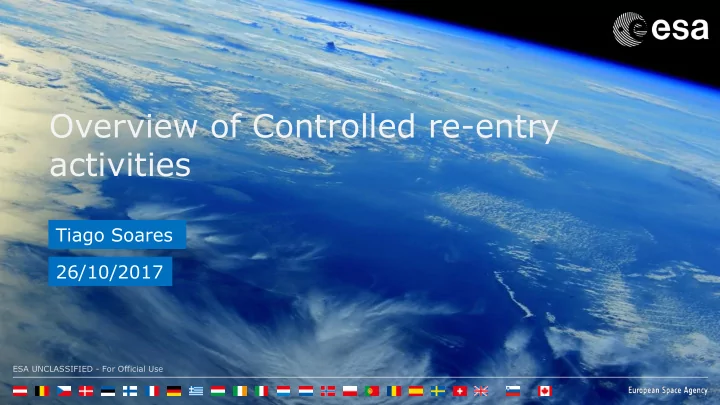

Overview of Controlled re-entry activities Tiago Soares 26/10/2017 ESA UNCLASSIFIED - For Official Use
Outline - Why controlled re-entry? - What does it entail? Technical challenges - Current technology solution - Possible solutions and range of applicability - Conclusions ESA UNCLASSIFIED - For Official Use Tiago Soares | 26/10/2017 | Slide 2
Why controlled reentry? - LEO satellites should perform an atmospheric reentry at the End of Mission. - With the current models, depending on the payload design even for relatively small spacecraft (~700 kg) may have a estimated casualty risk on ground above 10 -4 . Great uncertainty in early design phases, risk for recurrent platforms - Design for Demise is a complex design process that is still not fully understood or modelled - Systems for controlled reentry must be optimized but they are available and have been implemented in several systems in the past. Need for solutions to avoid mass increase leading to change launcher and that are affordable! ESA UNCLASSIFIED - For Official Use Tiago Soares | 26/10/2017 | Slide 3
What does it entails? Controlled reentry implies several technical challenges! - It has a significant impact at system level: - Huge impact on propellant mass (70% of MetOp SG propellant mass) - Need for high thrust - Need for re-pressurisation - Even with re-pressurisation before final burn, thrust level of MetOp SG falls to ~150N out of 400N - Impacts in AOCS - Need to control during large manouvre, sloshing, etc. - Impacts on thermal subsystem ESA UNCLASSIFIED - For Official Use Tiago Soares | 26/10/2017 | Slide 4
Current technical solution - At the moment the solution is an adaptation of the monopropellant system based on existing equipment - Inclusion of high thrust monopropellant engine(s) - series of 20N or single 400N (designed for launchers applications) - Increase of RCS thrust capacity - to 5N or 20N thrusters instead of 1N - Increase of propellant - can go up to ¾ of total propellant mass - Re-pressurisation e.g. done at end of life and before final burn. - Not regulated ESA UNCLASSIFIED - For Official Use Tiago Soares | 26/10/2017 | Slide 5
Possible solutions and range of applicability (1/3) Applicability - From work done with the primes: - the short to mid-term trend in LEO is to keep using monopropellant systems for medium to large platforms the ones needing controlled reentry. - Hence, solution complementing this system are of higher interest. - Electric Propulsion may be used in longer term evolutions of the LEO platforms or for some specific applications. - For those systems a simpler system such as solid rocket motors. ESA UNCLASSIFIED - For Official Use Tiago Soares | 26/10/2017 | Slide 6
Possible solutions and range of applicability (2/3) Improvement of monopropellant systems Reduce mass of propellant needed for a reasonable cost ! Solutions needed to increase Isp, improve thrust. Some solutions identified: - Electronic pressure regulators - Arcjets (using hydrazine with Isp ~550s rather than 230s) Reduce cost and improve efficiency - Low cost high thrust hydrazine engine ? - Hybrid propulsion solutions ? Reduce sloshing of high amount of propellant - Large monopropellant with sloshing control ESA UNCLASSIFIED - For Official Use Tiago Soares | 26/10/2017 | Slide 7
Possible solutions and range of applicability (3/3) Solid propulsion systems to support controlled reentry Development of solid rocket motors High thrust, compact, low cost. Some technical points still open: - Ageing of the propellant - Particle ejection - Thrust vector control Could it be the basis of an autonomous deorbit system? May be a nice solution for smaller satellites w/o or w/ limited propulsion capabilities or for ADR modules. ESA UNCLASSIFIED - For Official Use Tiago Soares | 26/10/2017 | Slide 8
Conclusions Controlled reentry Needs: perform controlled reentry without moving to a bigger launcher. Short term (<2020) Long term (>2020) Short term : Improved monopropellant 1 • Arcjets • Solid propulsion system to allow controlled deorbit with 2 deorbit system • Electronic pressure minimum mass impact. 1 regulator • Extended life 2 • Low cost high 2 HET thrusters Long term : Solid propulsion system to thrust engine (TBC) support controlled reentry of EP platforms or 2 smaller platforms without propulsion. Interest • Slosh control tanks on autonomy TBD. 1 High priority 2 Medium priority ESA UNCLASSIFIED - For Official Use Tiago Soares | 26/10/2017 | Slide 9
Recommend
More recommend